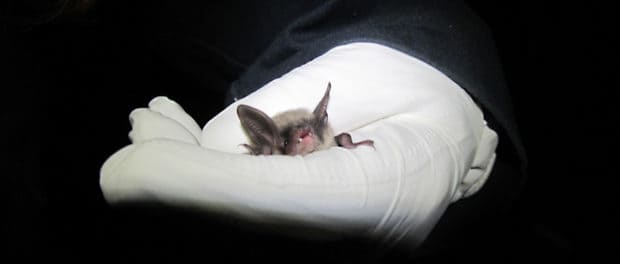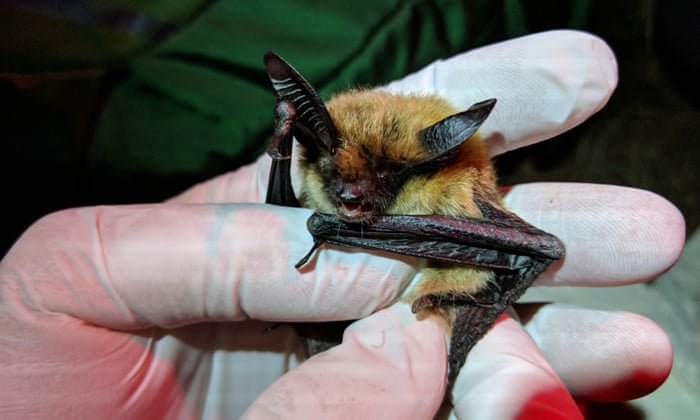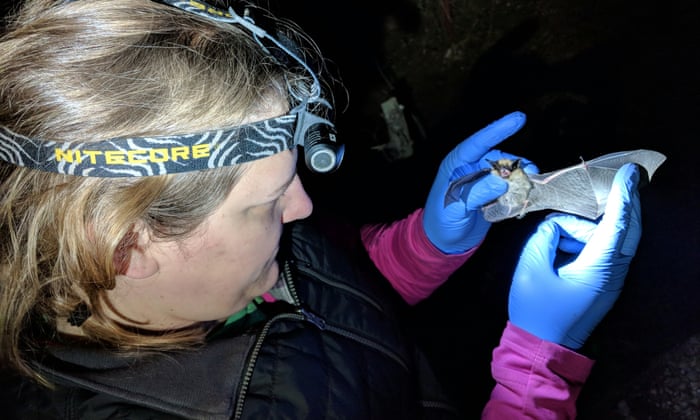Bat Fungal Scourge : White Nose Syndrome
"White-nose syndrome represents one of the most consequential wildlife diseases of modern times."
"The disease has killed millions of bats and threatens several formerly abundant species with extirpation or extinction."
Research paper, mSphere
"In areas like this where it's not yet arrived, we can form a predictive model based on ecology, physiology, genetics and skin chemistry."
Jonathan Reichard, official, United States Fish and Wildlife Service
"This research will inform us which bats will be susceptible and which will be resistant, which will inform a conservation and intervention strategy."
Sarah. H. Olson, director, wildlife health, Wildlife Conservation Society
 |
| An Indiana State University biologist searching for signs of white-nose syndrome holds a northern long-eared bat (Myotis septentrionalis). As the disease spreads, biologists are preparing for impacts on bats in the West. ©Scott Bergeson/Indiana State University |
"Disrupting them during hibernation is adding stress at a time they can least afford it."
"There's no practical way at all to slow or stop this, to get rid of it in the wild; it's already in thousands and thousands of [bat] roosts."
"It should be allowed to run its course. We're just wasting money when we try to find a cure. We should be spending our money on getting the maximum protection for the bats that have survived and helping them recover and rebuild populations."
"Using something to kill the fungus is going to kill other fungi or microorganisms in the cave that will cause other chain reactions and problems that are far greater than what we started with."
Merlin Tuttle, bat expert, Texas
 A hibernating Little Brown Bat showing visible signs of the fungus.
(Alan Hicks, New York State Department of Environmental Conservation
photo)
A hibernating Little Brown Bat showing visible signs of the fungus.
(Alan Hicks, New York State Department of Environmental Conservation
photo)There will always be some research scientists in any field, who disagree with the studies and findings of others; total consensus is difficult to obtain, a matter put to rest once one or the other camps is proven correct in a hypothesis that led them to an avenue to be explored which proves distinctly correct. That goal has yet to be reached in a conundrum which has stricken bat populations across a wide swath of North American geography with a fungal infection whose effects have been deadly to millions of bats since 2006.
Bats hibernate from September to April, lowering their heart rate and respiration for three weeks at a time. This is a diversion from how they have conventionally hibernated when hibernation is continuous and non-interrupted, conserving the fat stored in their tiny bodies to see them over the winter months until they awaken in the spring. That they waken after three weeks have elapsed and go in search of water is a result of bats infected with the fungus causes dehydration.
"During torpor they burn almost no energy. During arousal they burn a lot. Even though it's only five percent of their time, it's 95 percent of their energy. It really comes down to how often they arouse", explained Nathan Fuller, postdoctoral biologist from Texas Tech University, part of the research team of five biologists who entered an abandoned mine on a mountainside to pluck the tiny mammalian specimens from the walls in a collection meant to deliver some clues to solve the problem of dying bats.
A general, widespread effort is underway in North America for the purpose of understanding how a rapidly spreading fungal bat disease will affect bat populations in the western United States; their intention was expressed in the paper published in a journal of the American Society for Microbiology. Fuzzy spots appear on the noses of these mouse-size creatures in white-nose syndrome, leading to its name.
In the last decade, agencies representing state, tribal and federal entities and nonprofit groups have been attempting to find a way to save the 47 bat species in North America, with no luck as yet. The five biologists gathering bats off the walls in the mine brought the 30 bats they collected to a trailer where an animal MRI and respirometer were present, for the intention of weighing and measuring the tiny creatures.
 |
| Scientists across the western US and Canada are capturing and studying thousands of bats to discover which are best suited to survive the deadly white nose syndrome. Photograph: Wildlife Conservation Society |
Entire ecological landscapes could be altered, disrupting natural order, should the disease continue spreading and eliminating colonies of bats. First discovered in a cave outside Albany, New York in 2006, it was thought the fungus came from Eurasia, somehow introduced to North America where the pathogen has since spread to 36 U.S. states and seven Canadian provinces, wiping out entire bat colonies, totalling an estimated six million bat deaths.
The loss of these bats and the natural service they provide to the ecology in which they circulate could be monumental in its consequences, since they are pollinators and their voracious appetites make quick work of mosquitoes and other nuisance insects. The outbreak of the pathogen has ravaged the U.S. East Coast, and white-nose syndrome is spreading to the rest of the Western U.S. at a rate of roughly one state annually, meaning that in the next few years it might spread to the thousands of caves and abandoned mines of the Rockies.
A more complete biological map of bats' hibernation physiology gives hope to researchers that this could gain them a finer understanding of the process and how a strategy to defeat the effects of the fungus could be achieved. When the bats are forced to expend stored energy to take them through the winter months in a short-term survival mode brought on by white-nose syndrome, they become emaciated and die. Alternately, they might leave the cave sooner than they should in search of food, and die in the winter environment.
The research team has committed its time and energy and funding on equipment in an effort to more fully comprehend bat hibernation in the hope that once baseline data are established a solution may be found to this deadly dilemma. In the search for solutions heretofore, biologists have considered placing food in caves, feeding bats probiotics or electrolyes, or using chemical skin treatment to counter the fungus. They have tried fogging caves with antifungal agents.
And others, such as bat expert Merlin Tuttle urge patience and caution, hoping that the fungus might run its course, then possibly meet some obstacles not found in its native environment, and die off, leaving the remaining, uninfected bat groupings to repopulate.
 |
| A researcher inspects the body and wings of a bat collected for research. Photograph: Wildlife Conservation Society |
Labels: Biology, Research, White-Coat Syndrome

0 Comments:
Post a Comment
<< Home